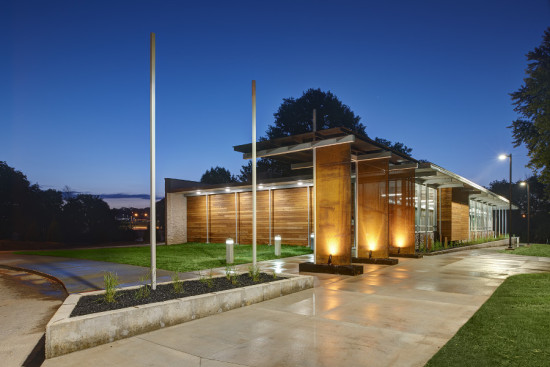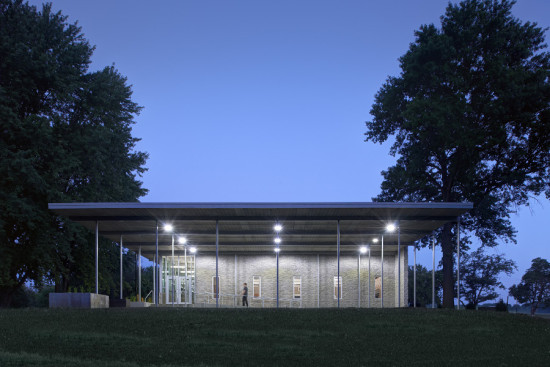
Architectural sleight of hand transforms a FEMA safe room from bunker to glass box.
Tasked with designing a community center on a shoestring budget, Des Moines–based ASK Studio was unsure how to fit the program to the project’s finances. Then an attendee at a community feedback session suggested applying for FEMA funds to build a combination community room and storm shelter. The FEMA tie-in solved the money problem, but it created an aesthetic challenge. The architects had originally diagrammed the community center, sited atop a central knoll in a large park in Urbandale, Iowa, as a connection point that would orient visitors without obstructing views. When the project was redefined as a safe room, said ASK’s Brent Schipper, “I just cringed, because how do you have a transparent node that’s also a tornado shelter? I thought, ‘We’re going to make a bunker, and pretend it works as the node of the centerpiece of the park.'” Luckily, Schipper’s gut reaction proved wrong. A triumph of architectural sleight of hand, ASK’s Giovannetti Community Shelter is built evidence that “welcoming safe room” is not an oxymoron.

The modified program in place, the architects began by asking themselves, “How do you achieve transparency when all you have is concrete walls?” said Schipper. They turned first to the roof line, adding a sense of weightlessness with a broad overhang above a picnic area. Though not part of the shelter function—it would likely shear off in the event of a serious storm—the overhang plays an important role in the structure’s aesthetic identity. Thanks to the canopy, “there are parts of the building that are light,” said Schipper. “You can’t tell it was a concrete box.”

- Facade Manufacturer
MPC Enterprises (precast wall panels), Molin Concrete Products (precast roof panels), Insulgard (tornado windows), Manko (storefront) - Architects
ASK Studio - Facade Installer
Steel Erectors of Iowa (concrete), Two Rivers Glass & Door (glazing) - Location
Urbandale, IA - Date of Completion
2013 - System
precast concrete roof and walls with storm-safe windows, exterior storefront and cedar siding - Products
precast concrete wall and roof panels, Insulgard storm-safe windows, Manko storefront, cedar siding
A second gesture further forestalls any temptation to identify Giovannetti Community Shelter with Cold War-era bunker architecture. A glass storefront (again not included in the shelter program) encloses the walkway connecting the shelter room to the rest of the park. “When you use the building, you’re always circulating in the corridor, so you’re always visually connected to the park,” said Schipper. “The glass belies the fact that the room you were just in is a storm shelter.” The curtain wall also defines the building’s exterior appearance, particularly on the south side. “What you see from the south elevation is a mostly glass structure with these very minimal roof lines,” said Schipper.
The tornado shelter itself was constructed from a 12-inch-thick precast concrete roof and wall panels. To keep the room from feeling too closed-off, ASK initially sketched in storm doors between the protected space and the glass corridor. Then the architects heard about Insulgard, whose tornado-safe windows had recently received FEMA approval. The architects ditched the door idea and instead installed safety windows (approximately 1 1/2 inches thick) on both the exterior walls and the wall between the shelter and the corridor. “[The design] would not have worked if you were in that room and you never had any glimpses of the outside,” said Schipper. “I was amazed by the technology of the storm windows.”
Though ASK faced several challenges in designing the Giovannetti Community Shelter, none of the firm’s solutions were overly complicated. “In the end, it’s a very simple parti,” said Schipper. “We were staking all of the drama, all of the messaging, on two moves: the overhang of the roof, and the transparency of the glass facade. When you back away, it’s like, ‘you only did two things.’ But those two things are particularly unique to the fact that it’s a tornado shelter.”





